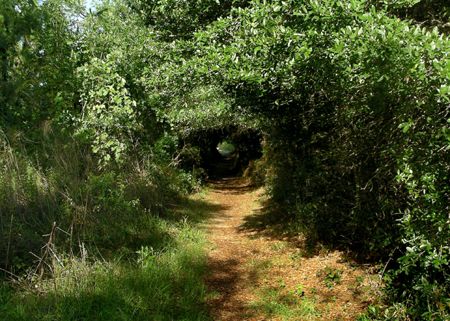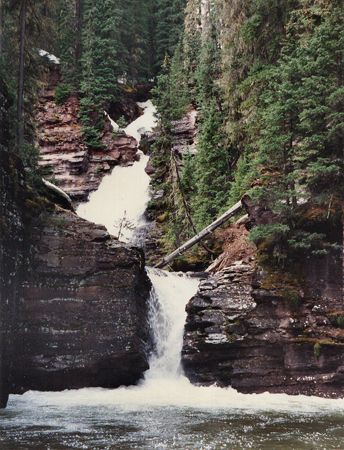February, 2019
Secret Places
by Valerie
Vast vistas are the highlight of any vacation. A returning adventurer has their smart phone packed with breathtaking photographs of towering mountains, splendid palaces, yawning canyons, dazzling glaciers and glorious sunsets, offering any viewer the chance to see the most memorable moments distilled from a two-week trek into the great wide world out there.
Or maybe not.
It might be a myopic mindset, but sometimes the hidden details of a place are what remain in my thoughts long after the visit is over. I've never been terribly keen on just the big picture; after the first sweeping impression, I relish the chance to explore the corners of a landscape, allowing a succession of smaller discoveries to gradually build my understanding of this particular point on our planet. Looking at a locale is not the same as being in it.
Perhaps this explains why I am not overly excited to visit places if I know I will only go there once and probably never return. A preamble unfulfilled can be quite frustrating. Lack of opportunity to realize the potential of a place translates into a truncated experience with insufficient information to form adequate perceptions. The idea of a "tour" is much less appealing than a chance to spend several days in an area, especially in one to which subsequent return trips are likely.
 I have fond memories of a little spring-fed creek adjacent to the Kankakee River in Illinois. As children, my sister and I were often left there to play while our parents went fishing. The spring emerged from a crack in the rocks fairly high up the embankment along the river. Long ago, somebody had inserted a pipe so the water flowed out far enough to allow a cup or bucket to be placed underneath. They also added a sort of metal box to contain a pool of water under the outpour. It was like a garden water feature, but more utilitarian than aesthetic. I remember that one time somebody placed a sizeable catfish in the tank. It was there for months.
I have fond memories of a little spring-fed creek adjacent to the Kankakee River in Illinois. As children, my sister and I were often left there to play while our parents went fishing. The spring emerged from a crack in the rocks fairly high up the embankment along the river. Long ago, somebody had inserted a pipe so the water flowed out far enough to allow a cup or bucket to be placed underneath. They also added a sort of metal box to contain a pool of water under the outpour. It was like a garden water feature, but more utilitarian than aesthetic. I remember that one time somebody placed a sizeable catfish in the tank. It was there for months.
A gravel-lined pool caught the water as it left the metal tank through a small chink in the rim. The rest of the stream was a series of small, but decidedly picturesque, waterfalls, created as the flow tumbled over the rock layers until it met the river. While the spring head was under tall trees, the vegetation along the lower part of the creek was more open, as that part of the river course was scoured by ice every winter. Depending on the weather, we could stay cool in the shade or bask in the sunshine. Whether my sister and I had our dolls camping on a rocky outcrop next to one of the 6-inch waterfalls (where they even made little campfires - yeah, our tolerant parents allowed us to have pocket knives and even matches), or created tiny rock corrals for the salamanders, or just turned over rocks to see what we could find underneath, it was an ideal place for children to while away the hours on a lazy summer day.
Access to the spring was by a well-worn path along the river that crossed the outflow stream not far below its source. Hikers and fishermen often walked past and, if we were playing near the springhead, we sometimes chatted with them, about the salamanders that lived there, whether the spring always flowed, what the various aquatic insect larvae were called. When asked if the water was safe to drink, I remember saying that I drank it all the time and had never gotten sick. Besides, it must be clean because the salamanders liked it.
There were several favorite spots in the vicinity of our home in Illinois, which was in the southwest part of the vast Cook County Forest Preserve District. We returned over and over to places like Sag Quarries, the Little Red Schoolhouse Nature Center and Saganashkee Slough, to watch wildlife, net minnows, eat wild strawberries, harvest walnuts, walk trails and sometimes just sit under a tree and do homework.
When I moved to Austin, Texas, I discovered more delightful little local gems. A small property called Wild Connections and a friend's yard in Manchaca were weekly destinations for years as I observed and photographed the fascinating flora and fauna. Two tracts of water quality protection land owned by the City of Austin are familiar because I lead public hikes on them a few times a year. I make regular weekly excursions at the Lady Bird Johnson Wildflower Center in order to document the animals that live there. At least that is the official reason for these ongoing visits. When it comes down to it, I really just like poking around in natural areas, and it's especially fun to have companions intent on doing the same.
Through the years, though, not all my pet places have been near my domicile. A number of visits to St. Joseph Peninsula State Park in Florida, each accompanied by a 14-mile day-long beach hike around the point, allowed me to become intimately familiar with a very different sort of landscape, as well as discover a couple of memorable spots along the way. The very tip of the sand spit was special because of the way it always changed. I loved the surprise of the transformations as well as the challenge of negotiating them to continue my journey. There might be large tide pools, which occasionally were separated from the Gulf of Mexico by narrow sand rims. Or there might be a deep channel severing the easy path and forcing a detour around the inland side of the water. Then there was that old, ratty pillow, lodged securely in a tangle of palm roots, that was my landmark for years at the end of my trek, signaling for me to search for the narrow path that led from the shoreline back to the campground.
Sometimes it only takes a few days of being somewhere to find a hidden treasure, a spot that is special enough to take one's breath away. Not all secret places are tiny and hidden. Our world is big enough to hold wonders that are just enough off the mainstream roads to be a surprise when serendipity strikes and we happen to stumble upon them.
The first time my husband, Larry, and I visited the South Mineral campground in Colorado's San Juan National Forest, we camped there for about a week, enjoying the various trails that led off in various directions and returning to our tent by a rushing stream each evening. Late in the afternoon on the final day of our vacation, I happened to wander along the stream, up a narrow, less obvious path that was not on any of the maps. As I pushed through overgrown shrubs and tangled branches of pines, I came upon an intriguingly rocky landscape. As I reached a sharp turn in the stream, I saw an amazingly magical scene: the water funneled down through a narrow crevice in a cliff, forming a stunning multi-tiered waterfall that was more impressive than any of the myriad vistas we had been seeing along the established hiking routes. Here, just minutes upstream from our campsite, was a panorama so unexpected that I literally felt my heart race as I realized the splendid luck of finding it. The light was fading, but I rushed back, told Larry, and we both returned to enjoy the view. The next morning afforded a little time for photography before we needed to head home, but you can bet that when we returned to that location again in a few years, we headed straight for that extraordinary scene.
All the clichés about the roads less traveled and getting off the beaten path aren't really without merit just because they are so familiar. It is, of course, possible to become jaded by the mindless repetition of such aphorisms, but, as with some legends and myths, there is a grain of truth at their foundation. When our own exploration reveals the hidden beauty in our world, the true value of secret places becomes very personal.
 I have fond memories of a little spring-fed creek adjacent to the Kankakee River in Illinois. As children, my sister and I were often left there to play while our parents went fishing. The spring emerged from a crack in the rocks fairly high up the embankment along the river. Long ago, somebody had inserted a pipe so the water flowed out far enough to allow a cup or bucket to be placed underneath. They also added a sort of metal box to contain a pool of water under the outpour. It was like a garden water feature, but more utilitarian than aesthetic. I remember that one time somebody placed a sizeable catfish in the tank. It was there for months.
I have fond memories of a little spring-fed creek adjacent to the Kankakee River in Illinois. As children, my sister and I were often left there to play while our parents went fishing. The spring emerged from a crack in the rocks fairly high up the embankment along the river. Long ago, somebody had inserted a pipe so the water flowed out far enough to allow a cup or bucket to be placed underneath. They also added a sort of metal box to contain a pool of water under the outpour. It was like a garden water feature, but more utilitarian than aesthetic. I remember that one time somebody placed a sizeable catfish in the tank. It was there for months.
